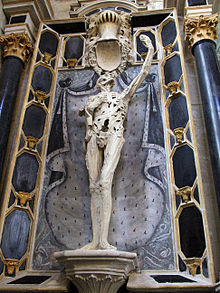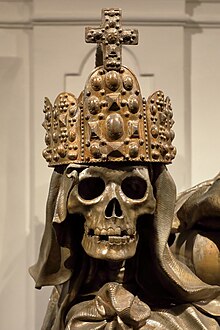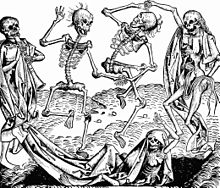Macabre




In
History
Early traces of macabre can be found in
- The series at Basel originally at the Klingenthal, a nunnery in Little Basel, dated from the beginning of the 14th century. In the middle of the 15th century this was moved to the churchyard of the Predigerkloster at Basel, and was restored, probably by Hans Kluber, in 1568. The collapse of the wall in 1805 reduced it to fragments, and only drawings of it remain.
- A Dance of the Dead in its simplest form still survives in the Marienkirche at Lübeck as 15th-century painting on the walls of a chapel. Here there are 24 figures in couples, between each is a dancing Death linking the groups by outstretched hands, the whole ring being led by a Death playing on a pipe.
- In St. Nikolaus Church (Niguliste), dating the end of 15th century.
- At Dresden there is a sculptured life-size series in the old Neustädter Kirchhoff, moved here from the palace of Duke George in 1701 after a fire.
- At Rouen in the cloister of St Maclou there also remains a sculptured danse macabre.
- There was a celebrated fresco of the subject in the cloister of Old St Pauls in London.
- There was another in the now destroyed Hungerford Chapel at Salisbury, of which only a single woodcut, "Death and the Gallant", remains.
- Of the many engraved reproductions of the Old St Pauls fresco, the most famous is the series drawn by Holbein.
The theme continued to inspire artists and musicians long after the medieval period, Schubert's string quartet Death and the Maiden (1824) being one example, and Camille Saint-Saëns' tone poem Danse macabre, op. 40 (1847).
In the 20th century, Ingmar Bergman's 1957 film The Seventh Seal has a personified Death, and could thus count as macabre.
The origin of this allegory in painting and sculpture is disputed. It occurs as early as the 14th century, and has often been attributed to the overpowering consciousness of the presence of death due to the
Etymology
The etymology of the word "macabre" is uncertain. According to Gaston Paris, French scholar of Romance studies, it first occurs in the form "macabree" in a poem, Respit de la mort (1376), written by the medieval Burgundian chronicler Jean Le Fèvre de Saint-Remy:[5]
Je fis de Macabree la dance,
Qui toute gent maine a sa trace
Et a la fosse les adresse.[5]
The more usual explanation is based on the Latin name, Machabaeorum chorea ("Dance of the
See also
- Body horror
- Black Death in medieval culture
- Danse Macabre, medieval allegory on the universality of death
- Danse macabre, tone poem written in 1874 by Camille Saint-Saëns
- Grimdark
- Horror fiction
- Memento mori, symbolic trope acting as a reminder of the inevitability of death
References
- ^ ISBN 9788816404335.
- ^ LCCN 2011050166.
- ^ "Roald Dahl Day: From Tales of the Unexpected to Switch Bitch, Dahl's undervalued stories for adults". The Independent. 14 October 2017.
- Du Cange, Gloss., s.v. Machabaeorum chora.
- ^ JSTOR 45042550. Retrieved 21 September 2022.
- ^ The Shorter Oxford English Dictionary (Fifth edition; 2002) states that the origin of "macabre" perhaps has reference to "a miracle play containing the slaughter of the Maccabees." Volume 1, p. 1659.
